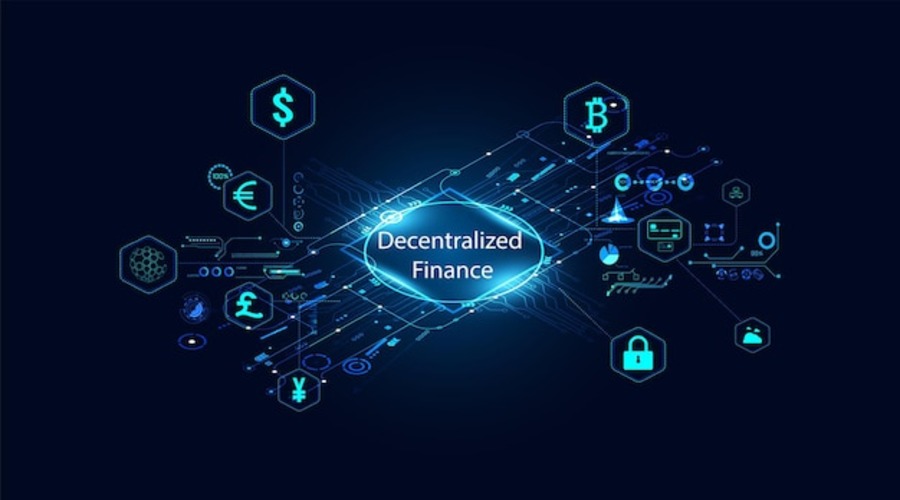In recent years, decentralized finance (DeFi) has gained significant popularity and transformed the financial landscape. DeFi systems offer an open, permissionless, and trustless environment for various financial transactions, including lending, borrowing, trading, and yield farming. While the potential of DeFi is immense, it is crucial to address the issue of centralized points of failure within these systems. In this article, we will explore the concept of centralized points of failure in DeFi and discuss strategies to mitigate these risks.
Introduction to DeFi Systems
Decentralized finance, or DeFi, has emerged as a groundbreaking concept that aims to revolutionize traditional financial systems. DeFi leverages blockchain technology to create an open and transparent ecosystem, enabling users to access financial services without relying on intermediaries like banks. However, despite the promise of decentralization, many DeFi systems still exhibit centralized points of failure, which can expose users to various risks.
Understanding Centralized Points of Failure in DeFi Systems
Centralized points of failure in DeFi refer to components within the system that are controlled or operated by a single entity or group. These entities may have excessive control over critical functions, such as managing user funds, governance decisions, or protocol upgrades. When such centralized components fail, it can lead to financial losses, security breaches, or disruptions in the system’s operations.
Risks Associated with Centralized Points of Failure in DeFi Systems
- Hacking and Security Breaches: One of the primary risks of centralized points of failure is the increased susceptibility to hacking and security breaches. If a single entity controls a significant portion of the system’s assets or infrastructure, it becomes an attractive target for malicious actors. A successful attack on a centralized component can result in the loss of user funds, compromising the trust and stability of the DeFi system.
- Single Points of Control: Centralized points of failure often arise from the presence of single points of control. When a single entity holds the power to make critical decisions or control key aspects of the system, it introduces a significant vulnerability. If this entity becomes compromised or acts maliciously, it can have severe implications for the entire DeFi ecosystem.
- Regulatory and Legal Challenges: Another risk associated with centralized points of failure in DeFi systems is the potential for regulatory and legal challenges. If a centralized component fails to comply with applicable regulations or falls under scrutiny, it can lead to legal action or regulatory intervention. This can disrupt the normal functioning of the system and create uncertainty for users and stakeholders.
Strategies to Address Centralized Points of Failure in DeFi Systems

To mitigate the risks associated with centralized points of failure in DeFi systems, several strategies can be employed:
Decentralization and Distribution
The fundamental principle of decentralization lies at the core of DeFi. By distributing control and decision-making power across a network of participants, the reliance on centralized points of failure can be reduced. DeFi protocols should strive to decentralize key functions, such as governance, asset custody, and oracle services, to ensure resilience and avoid concentration of power.
Multi-Signature Wallets
Implementing multi-signature wallets adds an extra layer of security to DeFi systems. Instead of a single private key controlling access to funds, multi-signature wallets require multiple parties to approve transactions. This mechanism reduces the risk of a single point of failure and enhances the security of user assets.
Auditing and Code Reviews
Thorough auditing and code reviews are essential to identify vulnerabilities and security flaws in DeFi protocols. Independent security audits help uncover potential risks and ensure that smart contracts are properly implemented. By addressing these vulnerabilities proactively, the likelihood of centralized points of failure can be significantly reduced.
Governance and Community Involvement
Decentralized governance models, driven by active community participation, play a crucial role in mitigating centralized points of failure. By involving a diverse range of stakeholders in decision-making processes, the system becomes more resistant to malicious intent and ensures that decisions are made in the best interests of the community as a whole.
Insurance and Risk Management
The availability of insurance and risk management solutions can provide additional safeguards against centralized points of failure. Insurance products tailored for DeFi can help protect user funds in the event of security breaches or smart contract vulnerabilities. By transferring some of the risks to insurance providers, users can have greater confidence in the system’s stability.
Interoperability and Cross-Chain Solutions
Promoting interoperability and cross-chain solutions can reduce reliance on single-blockchain networks, thereby minimizing centralized points of failure. Interoperability allows for the seamless transfer of assets and data across different blockchains, ensuring that the failure of one network does not jeopardize the entire system.
Case Studies: Addressing Centralization in DeFi Systems
Let’s explore a few case studies that highlight efforts to address centralized points of failure in DeFi systems:
- MakerDAO and Dai Stablecoin: MakerDAO, a decentralized autonomous organization, has developed the Dai stablecoin, which aims to maintain a stable value through an algorithmic process. By utilizing collateralized debt positions (CDPs) and decentralized oracles, MakerDAO reduces reliance on centralized authorities and provides a decentralized stablecoin solution.
- Uniswap and Automated Market Makers: Uniswap, a popular decentralized exchange (DEX), operates using an automated market maker (AMM) model. By eliminating order books and relying on smart contracts, Uniswap reduces the need for intermediaries and centralized exchanges. Users can trade tokens directly from their wallets, maintaining control over their assets.
- Compound and Money Markets: Compound is a decentralized lending platform that allows users to lend and borrow various cryptocurrencies. By leveraging smart contracts, Compound automates the lending process and removes the need for intermediaries. Users can directly interact with the protocol, earning interest or borrowing assets without relying on centralized institutions.
The Importance of Decentralization in DeFi Systems
Decentralization lies at the heart of the DeFi movement and is a key factor in addressing centralized points of failure. By distributing control and decision-making power among a network of participants, DeFi systems aim to create a trustless and transparent environment. Decentralization ensures that no single entity has excessive control, reducing the risks associated with centralization.
Decentralized systems achieve consensus through mechanisms such as proof-of-stake (PoS) or proof-of-work (PoW), where participants validate and secure transactions. This consensus mechanism eliminates the need for a centralized authority, ensuring that no single point of failure can compromise the integrity of the system. By empowering individual users and fostering community involvement, decentralized governance models promote inclusivity and fairness.
Enhancing Security through Immutable Smart Contracts
Smart contracts, the building blocks of DeFi applications, are self-executing agreements written in code. These contracts automate transactions and enforce predefined rules, eliminating the need for intermediaries. However, if smart contracts contain vulnerabilities, they can be exploited, leading to significant financial losses.
To address this risk, thorough auditing and code reviews are crucial. Qualified auditors carefully examine smart contracts to identify potential security flaws and vulnerabilities. Code reviews involve assessing the logic, structure, and overall design of the contract. By conducting audits and code reviews, developers can identify and rectify vulnerabilities before deploying smart contracts, minimizing the chances of centralized points of failure.
Additionally, the immutability of smart contracts adds an extra layer of security. Once deployed on the blockchain, smart contracts cannot be altered or tampered with. This feature ensures that the terms and conditions of transactions remain unchanged, providing users with confidence and reducing the risk of manipulation or fraud.
The Role of Interoperability in Mitigating Centralized Points of Failure
Interoperability refers to the ability of different blockchain networks and DeFi protocols to communicate and interact seamlessly. Currently, the DeFi ecosystem comprises various blockchain networks, each with its own strengths and limitations. However, relying on a single blockchain network can create a centralized point of failure.
By promoting interoperability, DeFi protocols can mitigate this risk. Interoperability allows users to transfer assets and data across different blockchains, reducing dependence on a single network. In the event of a failure or disruption in one blockchain, users can seamlessly transition to alternative networks, ensuring continuity and resilience.
Cross-chain solutions, such as bridge protocols or wrapped tokens, enable the transfer of assets between different blockchains. These solutions facilitate liquidity, foster innovation, and enhance the overall security of the DeFi ecosystem. By embracing interoperability, DeFi systems become more robust, scalable, and less susceptible to centralized points of failure.
The Future of DeFi: Building Resilient and Trustless Systems
The evolution of DeFi is an ongoing process, and the industry must continue to address centralized points of failure. By prioritizing decentralization, enhancing security measures, and fostering community participation, the DeFi ecosystem can build resilient and trustless systems. As technology advances and best practices emerge, the potential for DeFi to reshape traditional finance becomes increasingly tangible.
Conclusion
Centralized points of failure present inherent risks within DeFi systems. Addressing these risks is crucial to foster trust, security, and widespread adoption. By implementing strategies such as decentralization, multi-signature wallets, auditing, governance, insurance, and interoperability, the DeFi industry can mitigate the vulnerabilities associated with centralized points of failure. As the ecosystem continues to mature, it is essential to prioritize the development of robust, decentralized solutions that empower individuals and redefine the future of finance.
FAQs
1. Can decentralized systems be completely free of centralized points of failure?
While decentralized systems aim to minimize centralized points of failure, achieving absolute decentralization can be challenging. However, by implementing various strategies and best practices, decentralized systems can significantly reduce the risks associated with centralization.
2. How can users protect their funds in decentralized finance?
Users can protect their funds in decentralized finance by practicing good security hygiene. This includes using hardware wallets, implementing strong passwords, enabling two-factor authentication, and conducting thorough research on the projects they interact with.
3. Are there any regulatory challenges associated with DeFi systems?
Yes, regulatory challenges are a significant consideration in the DeFi space. As governments and regulatory bodies catch up with the technology, compliance requirements and legal frameworks may evolve. DeFi projects should aim to proactively engage with regulators to ensure compliance and minimize regulatory risks.
4. How can DeFi protocols ensure the accuracy of external data sources?
DeFi protocols often rely on external data sources, such as price feeds or market data. To ensure accuracy and minimize the risks of manipulation, protocols can implement decentralized oracle solutions that aggregate data from multiple sources and utilize consensus mechanisms.
5. What role does user education play in addressing centralized points of failure?
User education is paramount in mitigating risks associated with centralized points of failure. By educating users about best practices, security measures, and the potential risks involved, individuals can make informed decisions and actively participate in securing their funds and the overall DeFi ecosystem.

